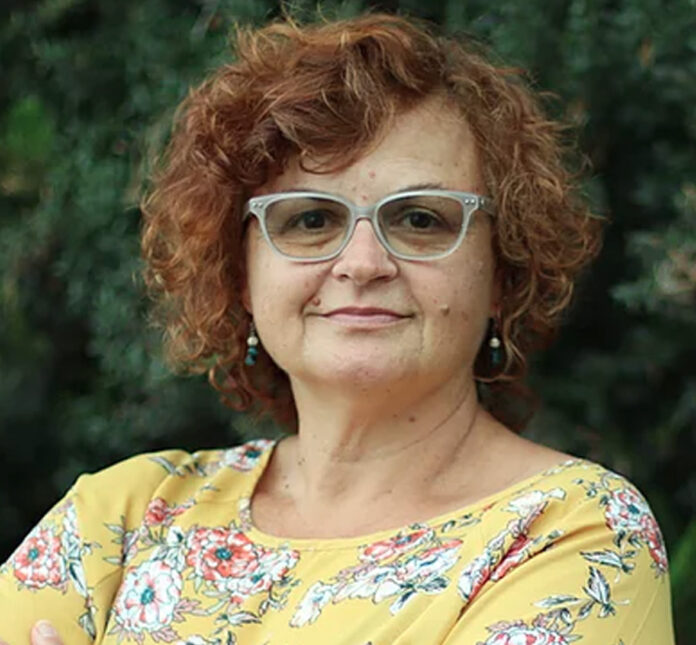City of San Diego Senior Planner Kathleen Brand is a La Mesa resident running against five other candidates in a special election to fill the La Mesa City Council seat formerly held by Akilah Weber, who departed to serve in California State Assembly District 79. There is about one year left in the term and the seat will be up for re-election in November 2022.
Brand, 58 said she has volunteered with the city of La Mesa for 20 years, has regularly attended city council meetings for the past decade, and believes that her professional experience in urban planning and landscape architecture would be of benefit to the city as she is well-versed in California state land use codes and regulations.
Among her top priorities: affordable housing, a flexible approach to city improvements, and a mixed-use approach to building.
One of the first things to do, she said, is look “holistically” at California State Bill 9, which focuses on the creation of accessory dwelling units by local ordinance and California State Bill 10 that allows development of up to 10 residential units per parcel.
“People think ADUs will be cheaper because they’re smaller but we’re learning from apartment complexes that small is not necessarily cheap to build. The lowest cost for an ADU is about $200,000 and to me that is nothing to sneeze at. I want to encourage incentives to build with Universal Design so it could be a unit for seniors, perhaps offer a big reduction in developer permit fees if they’re willing to do it,” Brand said.
The city could help homeowners build ADUs by developing a few standard plans, presumably to save planning dollars, while simultaneously taking La Mesa’s unique landscape with items like stormwater regulations and retaining walls considered during the planning process.
“We could do workshops like those at the Water Conservation Garden at Cuyamaca College— designers walk through home plans with homeowners. We could do the same thing, have workshops with staff, host resident events for them to learn ‘what would be easiest on my site, what am I anticipating in my length of time to permit’ and really learn what it would take to build an ADU,” Brand said.
She would also like to see the city listen to resident suggestions about park improvements, and disagrees with the current standard of waiting for large-scale redesign efforts rather than filling in with temporary or small improvements.
“People have asked for a dog park in MacArthur park but the city won’t spend money to even put up a fence because, as a practice, they don’t spend money on infrastructure,” Brand said, while the city continues to develop extensive plans for a new park with a $70 million price tag.
With just $20,000 collected in 2021 parking fees, that $70 million park would take 30 years to fund, she said, or require another bond measure.
The city has plans but without having the money to implement those plans little can be accomplished and she would rather see the city “more flexible, a limber city with temporary improvements” that benefit residents in the here and now.
She would also like to see a shift toward equitably improving the entire city.
“La Mesa spends a lot of its money on downtown and the surrounding area. You have a $70 million plan for MacArthur park but failing retaining walls in Rolando and missing play equipment in Northmont. The city doesn’t look at itself comprehensively and that goes for parks and our neighborhoods,” Brand said.
Ideally, she said, streets like University Avenue and El Cajon Boulevard need improvements, while the Lake Murray area must remain mixed-use in design.
“We need to look toward building retail commercial on the bottom floor with housing above. We have to stop allowing developers to build 100% housing,” Brand said, as spaces must be configured with residents’ needs, accessibly located and with amenities designed into neighborhoods.
As an example, she believes a new library, “promised ten years ago” has less to do with location than how it gets funded and how that funding determines design.
“I think we should go toward a public-private partnership on that giant lot next to city hall, and it should have a library, convention center and theater type facility on the bottom floor with housing up above. I’d like to see a developer build out, at minimum, the shell so residents don’t have to go through another bond measure again,” Brand said.
That approach would ensure a developer gets to build profitable housing while the city would benefit from getting the public facilities they need, she said, not unlike a Banker’s Hill property where developers built market rate housing alongside St. Paul’s cathedral while simultaneously improving the courtyard and shared community amenities.
“We have to leverage our assets to ensure we are not just constantly raising taxes,” Brand said.
At the same time, she is pursuing a study to compare what La Mesa charges for developer fees compared to surrounding areas of East County, believes the city simply needs more affordable housing.
“People fall through the cracks. I don’t believe everyone out there wants to be homeless. I’ve talked to people downtown and it’s not their first option- they were sleeping at a friend’s place and had to leave or they lost their apartment… We have to work with the county and surrounding neighbors of El Cajon, Santee to have a united front,” Brand said.
Even a small, local emergency shelter would be beneficial, she said, along with supportive housing units and wraparound services, partnerships with faith-based communities and working alongside the La Mesa Police Department’s HOME outreach program.














